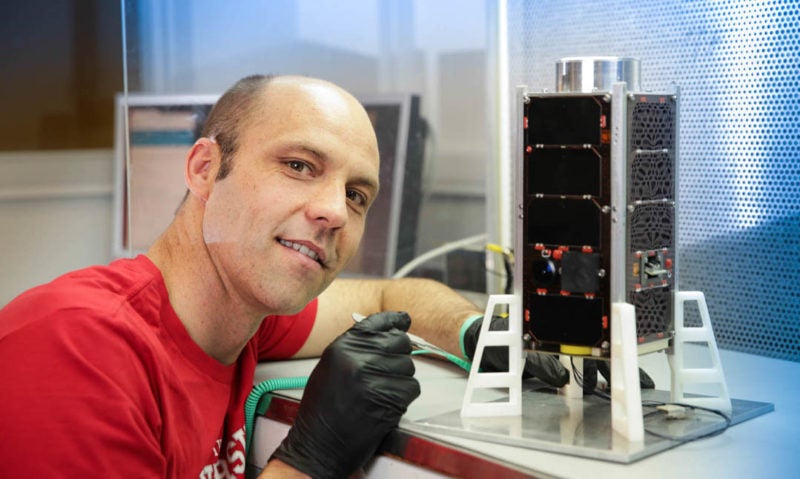Are Optical Satellites the Best Solution to Monitor Orbital Debris?

Inovor CEO Matthew Tetlow with the company’s first CubeSat. Photo: Inovor/The Lead South Australia.
Australian nanosatellite startup Inovor Technologies has proposed a new potential solution to monitor orbital debris: using optical sensors from Low Earth Orbit (LEO) to track space junk further out in Geosynchronous Earth Orbit (GEO). According to Inovor’s Chief Executive Officer (CEO) Matthew Tetlow, who spoke with Via Satellite by email, optical systems are in fact the only feasible solution to provide Space Situational Awareness (SSA) in GEO because ground-based radar systems don’t have the range to observe that far out in space.
“Ground-based systems can be very large and able to detect very faint objects but they are restricted to operating at night and when the weather is clear. Space-based systems don’t have the weather/environment problem but they’re expensive to deploy, especially with large optics. As such, there are not many out there,” Tetlow said.
The Joint Space Operations Center (JSpOC), located at Vandenberg Air Force Base in California, uses a mixture of technologies including the Space-Based Surveillance System (SBSS) to track objects in orbit. Still, the organization and others conducting similar work rely largely on ground-based radar and optical systems spread across the globe. As a result of these limited sensors, JSpOC is only able to consistently track objects between 1cm and 10cm — approximately the size of a softball — despite the fact that an object as small as a marble is potentially enough to destroy a spacecraft. According to Tetlow, Inovor will contribute an additional layer of support, as it can track most objects of interest “but more importantly, offer a new capability of near-persistent tracking of any particular object,” he said.
However, as Tetlow admits, using small optics in LEO to find even smaller objects in GEO is not an easy task. “The further away you are from an object, the larger the optic required to capture the object and distinguish it from a nearby object. In addition to this you need the image resolution to be high enough to have each pixel represent a small enough area out where the object is that you can resolve its position,” he said.
To bolster the accuracy of its system, Inovor will incorporate statistical analysis to estimate a particular object’s location once it’s detected. The benefit of having multiple nanosatellites in the constellation is that they can take more than one observation of the same object to more precisely hone in on its location. “Being able to resolve an object is different from being able to detect it. With long integration times and novel image processing techniques we expect to be able to detect fairly faint objects out at GEO, but won’t know exactly where it is inside the pixel view, hence the use of the statistical methods based on multiple observations,” Tetlow said.
According to Tetlow, Inovor will buy its sensors from a partner organization, most likely an Australian defense prime contractor. The optic will be a Cassegrain reflector, he said, similar to optical telescopes, and will be able to achieve a resolution better than 2m in the visible bands.
Inovor tested its first nanosatellite on-orbit in April along with 50 other CubeSats launched as part of the European-funded QB50 project. One of the biggest takeaways from the company’s first launch, Tetlow said, was that Commercial Off-the-Shelf (COTS) components aren’t as low-risk as they are perceived to be. “These are complex subsystems that are essentially ‘black boxes’ as the customer has very little information about how the system actually works and, as such, it is very difficult to troubleshoot when you are working with multiple COTS parts. I think this is why vendors are moving to supply whole buses instead of components and subsystems,” he explained.
Inovor continues to tweak the design of its optical nanosatellites, and will display the technology this September at the International Astronautical Congress (IAC) in Adelaide.
Adelaide, and South Australia as a whole, is quickly becoming a tech hub, home to other space startups including Fleet and Neumann Space.
Like his peers, Tetlow noted that he too fully supports the creation of a national space body, especially given the rapidly growing space startup community in South Australia. “I hope it will bring focus to the growing space industry by providing a clear point of contact for international space agencies to connect with to build collaborative international space projects. We have some niche capabilities in Australia, but no one in government is out there supporting its development or selling it to international space players,” he said. “I also hope the agency comes with some funding to kick off the growing space industry.”